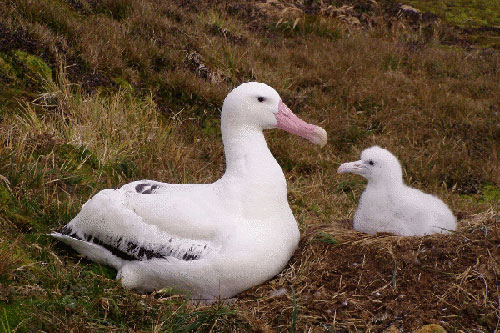Vincent Lecomte has this year been awarded the degree of Docteur de l'Universite de Poitiers for his study of the effects of senescence in two long-lived seabirds, the Wandering Albatross Diomedea exulans and the Snow Petrel Pagodroma nivea.
The English abstract for the thesis (which has been written in French) follows:
"Ageing in the wild: a multidisciplinary approach in two long-lived seabirds, the Wandering Albatross and the Snow Petrel
Very little is known on the deterioration of physiological and behavioural performances with age in wild animals. Given the multifaceted nature of senescence, identifying the effects of age on physiology and behaviour remains a challenging. We investigated the effects of age on a broad array of phenotypic traits in two long-lived seabirds, the Wandering Albatross Diomedea exulans (age 2-48+ years; Ile de la Possession, Southern Indian Ocean) and the Snow Petrel Pagodroma nivea (age 7-46 years; Terre Adelie, Antarctica). We studied foraging behaviour using satellite tracking and miniaturized activity loggers, and monitored reproductive performance. An array of phenotypic traits (immune function, levels of oxidative stress, antioxidant defenses, baseline hormonal levels, endocrine and cardiac stress responses) known to reflect senescence in vertebrates was also examined. In Wandering Albatrosses, there was age related patterns in foraging behaviour, stress response and reproductive performance, but not in baseline physiology. There was an unexpected pattern of spatial segregation by age in the foraging areas of male albatrosses. Old males, but not females, travelled a greater distance but were less active at the sea surface, and exhibited low foraging efficiency, suggesting that foraging ability (i.e. the ability of individuals to extract energy from their environment) might play a central role in shaping ageing patterns in natural conditions. Moreover, the stress response of non-breeding males, but not breeding males, was affected by age, suggesting that age-related patterns are enhanced when individuals face ‘challenging' conditions. In contrast, there was no detectable effect of age in females, suggesting that senescence rates are sex-specific in wild seabirds, as in humans an in laboratory model animals. In Snow Petrels, there was no detectable effect of age on PHA-induced immune response, PHA-induced hormone levels, chick growth or chick physiology, suggesting that physiological senescence is difficult to detect in this very long-lived seabird. Overall, our results highlight that age, gender, reproductive status and foraging ability interact in shaping ageing patterns in natural conditions, and suggest that long-lived seabirds maintain a high level of physiological fitness in old age, which supports the disposable soma theory."

Lecomte, V.J. 2010. La sénescence en milieu naturel: une étude pluridisciplinaire chez deux oiseaux marins longévifs, le Grand Albatros et le Pétrel des Neiges. Thèse de Doctorat, Université de Poitiers, France. 268 pp. http://www.cebc.cnrs.fr/Fthese/PUBLI/Lecomte.pdf.
For a co-authored paper published from his thesis by Vincent Lecomte click here.
John Cooper, ACAP Information Officer, 14 December 2010

 English
English  Français
Français  Español
Español